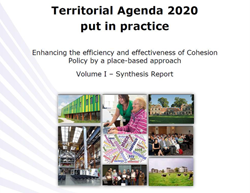Territorial Agenda 2020 put in practice - Enhancing the efficiency and effectiveness of Cohesion Policy by a place-based approach

This study analyses 21 cases from all over Europe, with different thematic foci and on different geographical scales. It shows that a place-based approach is already being applied in Cohesion Policy and that this can give tangible results. The most important lesson from this analysis is that before anything else a, sometimes rather drastic, change in the mind-set of decision makers is needed.
Along with the progressive recognition of the concept “territorial cohesion”, different initiatives have been trying to draw on its practical implications. An important step is the adoption of the “Territorial Agenda of the European Union 2020” in 2011 that provide strategic orientations for territorial development, promoting place-based policy making.
Through the illustration of a number of real life examples putting in practice the principles of a place-based approach, the present study contributes to the wider implementation of this agenda. Evidence collected shed light on advantages but also challenges of such approaches and discusses why, together with its constituting features, it proved to be a key success factor for the initiative considered.
The result is a discussion on common keys that can be detected and pointed to as footprint for decision makers. While some elements refer to the usual aspects associated with a place-based approach, namely working in an integrated manner and multilevel dialogue, other key aspects are relatively novel or original and shed light on the fact that place-based approach is a flexible policy choice which can be more successful in delivering the Europe 2020 strategy than traditional approaches, typically single-sector and top-down.
